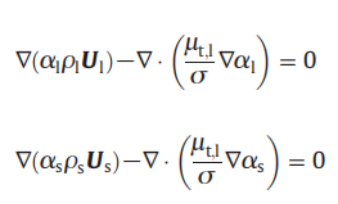reactingtwophaseeulerfoam?
-
The source term in Eq. (24) does not come from the laplacian term. It comes from the convection term. Eq. (24) is not related to your posted equations. The laplacian terms in your posted image are turbulent dispersion terms. In OpenFOAM they are not implemented in this manner.
-
@东岳 If I understand well, equation (24) was changed by the sum of two mass conservation equation. However I must add that term in the mass conservation equation. So the position I implemented the laplacian term is right? The mass conservation equation shown in picture is our own equation.
-
@东岳 Frankly, I use the minus sign and I got the results however they doesn't agree well with the results from PHOENICS. The velocity profile seems shift in some degree. So I would like to try "plus" this term. I am not sure the place I added is right or not. When I change one to be plus and the other to be minus, it runs well and the results seems better.
-
@东岳 Sorry. I am still confused that how the equation(24) mentioned in your page could be solved in OpenFoam. In the source code:
solve ( pEqnComp1() + pEqnComp2() + pEqnIncomp, mesh.solver(p_rgh.select(pimple.finalInnerIter())) );why
pEqnComp1() + pEqnComp2() + pEqnIncompranther than- pEqnComp1() - pEqnComp2() + pEqnIncomp. Because in your equation(24), pEqnComp1() + pEqnComp2() in the right side while pEqnIncomp in the left side. -
Thanks for your feedback. The R.H.S. of the following equation should be a
-sign. It was corrected.
\begin{equation}\label{comp_nablaU}
\underset{\mathrm{pEqnIncomp}}{\underbrace{\nabla\cdot\left(\alpha_\rd\bfU_\rd+\alpha_\rc\bfU_\rc\right)}}=\underset{\mathrm{\color{red}{-}pEqnComp1\color{red}{-}pEqnComp2}}{\underbrace{-\frac{\alpha_\rd}{\rho_\rd}\frac{\rD\rho_\rd}{\rD t}-\frac{\alpha_\rc}{\rho_\rc}\frac{\rD\rho_\rc}{\rD t} }}.
\end{equation}What is the first term? Its a second order tensor which is not consistent with the second term (scalar).

